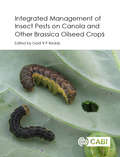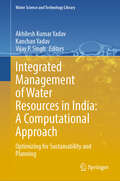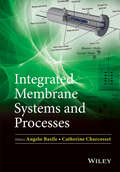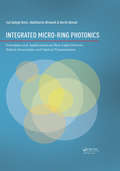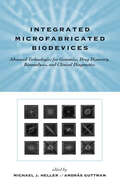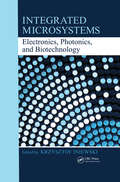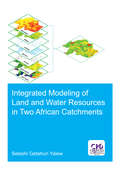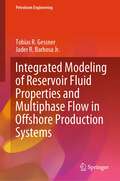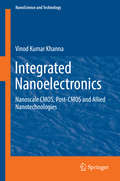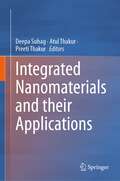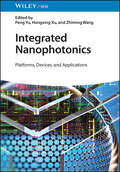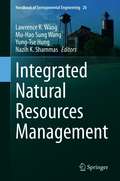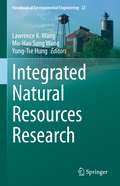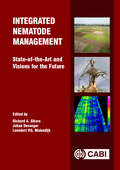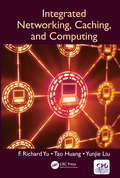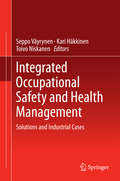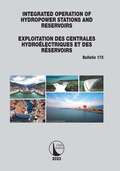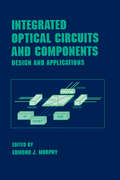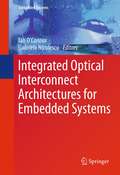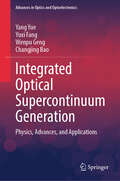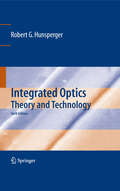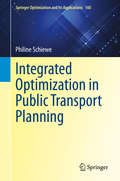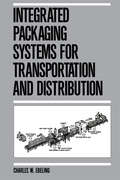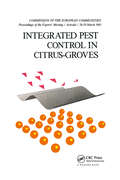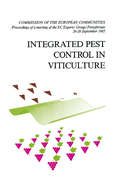- Table View
- List View
Integrated Management of Insect Pests on Canola and Other Brassica Oilseed Crops
by Gadi V.P. ReddyThis book comprehensively reviews current pest management practices and explores novel integrated pest management strategies in Brassica oilseed crops. It is essential reading for pest management practitioners and researchers working on pest management in canola and other Brassica crops worldwide. Canola, mustard, camelina and crambe are the most important oilseed crops in the world. Canola is the second largest oilseed crop in the world providing 13% of the world's supply. Seeds of these species commonly contain 40% or more oil and produce meals with 35 to 40% protein. However, its production has declined significantly in recent years due to insect pest problems. The canola pest complexes are responsible for high insecticide applications on canola. Many growers rely on calendar-based spraying schedules for insecticide applications. The diamondback moth Plutella xylostella and flea beetles Phyllotreta spp. (P. cruciferae and P. striolata)cause serious damage to canola. In the Northern Great Plains, USA, for instance, P. xylostella is now recorded everywhere that canola is grown. Severe damage to canola plants can be caused by overwintering populations of flea beetles feeding on newly emerged seedlings. Cabbage seed pod weevil (Ceutorhynchus obstrictus), swede midge (Contarinia nasturtii), and tarnished plant bug (Lygus lineolaris) are also severe pests on canola. Minor pests include aphids (cabbage aphid, Brevicoryne brassicae and turnip aphid, Hyadaphis erysimi) and grasshopper, Melanoplus sanguinipes. This book: #65533; is the only single compiled source of information on integrated management of canola and other Brassica oilseed pests #65533; presents the biology and management of all the major and minor pests of Brassica oilseed crops #65533; is an essential source of information for applied entomologists, crop protection researchers, extension agents and stakeholders
Integrated Management of Water Resources in India: Optimizing for Sustainability and Planning (Water Science and Technology Library #129)
by Vijay P. Singh Akhilesh Kumar Yadav Kanchan YadavThis book tackles the complexities of water management in India. Using computational tools, it provides comprehensive information on water availability, demand, climate change, integrated management, and governance. A must-read for researchers, policymakers, and water managers. The book is structured to provide a holistic understanding of water resources in India and the need for an integrated approach to their management. It explores various aspects of water management, including data collection and analysis, water allocation and planning, water quality management, and the intricate interdependencies within the water-energy-food nexus. One of the key focuses of this book is the application of computational approaches in the management of water resources. We explore the use of advanced modeling, simulation, and optimization techniques to facilitate decision making, assess water availability, and predict future scenarios. By employing computational tools, our goal is to bridge the gap between theoretical concepts and practical implementation, empowering water managers, policymakers, researchers, and other stakeholders to make informed and effective decisions. Throughout the book, we present case studies highlighting the application of computational approaches in diverse water management scenarios in India. These case studies offer valuable information on real-world challenges and demonstrate the potential of computational techniques to address complex water resources problems. We also explore the importance of stakeholder engagement, participatory approaches, and collaborative governance models, recognizing the importance of inclusive decision-making processes and local knowledge in achieving sustainable water management. The book is expected to serve as a valuable resource for students, researchers, professionals, and policymakers involved in water resource management in India. We aim to contribute to the ongoing efforts to ensure the availability of clean and adequate water resources for present and future generations.
Integrated Membrane Systems and Processes
by Angelo Basile Catherine CharcossetThe book examines the possibility of integrating different membrane unit operations (microfiltration, ultrafiltration, nanofiltration, reverse osmosis, electrodialysis and gas separation) in the same industrial cycle or in combination with conventional separation systems. It gives careful analysis of the technical aspects, and the possible fields of industrial development. The book reviews many original solutions in water desalination, agro-food productions and wastewater treatments, highlighting the advantages achievable in terms of product quality, compactness, rationalization and optimization of productive cycles, reduction of environmental impact and energy saving. Also included are examples of membrane reactors and their integration with a fuel cell; polymeric membranes in the integrated gasification combined cycle power plants; integrating a membrane reformer into a solar system; and potential application of membrane integrated systems in the fusion reactor fuel cycle. With detailed analysis and broad coverage, the book is divided into two sections: Bio-applications and Inorganic Applications.
Integrated Micro-Ring Photonics: Principles and Applications as Slow Light Devices, Soliton Generation and Optical Transmission
by Iraj Sadegh Amiri Harith Ahmad Abdolkarim AfroozehMicro-ring resonators (MRRs) are employed to generate signals used for optical communication applications, where they can be integrated in a single system. These structures are ideal candidates for very large-scale integrated (VLSI) photonic circuits, since they provide a wide range of optical signal processing functions while being ultra-compact. Soliton pulses have sufficient stability for preservation of their shape and velocity. Technological progress in fields such as tunable narrow band laser systems, multiple transmission, and MRR systems constitute a base for the development of new transmission techniques. Controlling the speed of a light signal has many potential applications in fiber optic communication and quantum computing. The slow light effect has many important applications and is a key technology for all optical networks such as optical signal processing. Generation of slow light in MRRs is based on the nonlinear optical fibers. Slow light can be generated within the micro-ring devices, which will be able to be used with the mobile telephone. Therefore, the message can be kept encrypted via quantum cryptography. Thus perfect security in a mobile telephone network is plausible. This research study involves both numerical experiments and theoretical work based on MRRs for secured communication.
Integrated Microfabricated Biodevices: Advanced Technologies for Genomics, Drug Discovery, Bioanalysis, and Clinical Diagnostics
by Andras Guttman Michael J. HellerThis book discusses the new generation of integrated microfabricated devices, including DNA chips, Lab-on-a-Chip, microcapillary electrophoresis systems, biosensors, and microanalytical systems. It traces their development with the established and evolving technologies such as microlithography, micromachining, microelectromechanical systems, microf
Integrated Microsystems: Electronics, Photonics, and Biotechnology (Devices, Circuits, and Systems)
by Iniewski KrzysztofAs rapid technological developments occur in electronics, photonics, mechanics, chemistry, and biology, the demand for portable, lightweight integrated microsystems is relentless. These devices are getting exponentially smaller, increasingly used in everything from video games, hearing aids, and pacemakers to more intricate biomedical engineering and military applications. Edited by Kris Iniewski, a revolutionary in the field of advanced semiconductor materials, Integrated Microsystems: Electronics, Photonics, and Biotechnology focuses on techniques for optimized design and fabrication of these intelligent miniaturized devices and systems. Composed of contributions from experts in academia and industry around the world, this reference covers processes compatible with CMOS integrated circuits, which combine computation, communications, sensing, and actuation capabilities. Light on math and physics, with a greater emphasis on microsystem design and configuration and electrical engineering, this book is organized in three sections—Microelectronics and Biosystems, Photonics and Imaging, and Biotechnology and MEMs. It addresses key topics, including physical and chemical sensing, imaging, smart actuation, and data fusion and management. Using tables, figures, and equations to help illustrate concepts, contributors examine and explain the potential of emerging applications for areas including biology, nanotechnology, micro-electromechanical systems (MEMS), microfluidics, and photonics.
Integrated Modeling of Land and Water Resources in Two African Catchments
by Seleshi Getahun YalewDemand for land and water for agriculture, urbanization, irrigation, hydropower, and industrialization is increasing to meet the demands of growing populations and of growing economies. However, changes in land and water resources are often studied separately. A better representation of the interaction between land-use change and its drivers on the one hand and water resources on the other is imperative for sustainable environmental management. This research investigates and develops spatial analysis methods and tools for the quantification of dynamic feedbacks between land-use change and water resources, by focusing on case study catchments in Ethiopia and South Africa. Furthermore, the research investigates methods for analysing land-use suitability and modelling land-use change. Results show that major changes in land-use have been observed in the past two to three decades in the study catchments. Model representation of the interaction between land-use change and water resources shows that changes in land-use influence hydrologic responses. These influences are especially pronounced during high- and low-flow seasons. Likewise, hydrologic processes and water resources availability influence land-use suitability and hence land-use change responses. Accounting for the dynamic feedback between land-use and hydrology thus produces improved knowledge that can better inform integrated natural resources management.
Integrated Modeling of Reservoir Fluid Properties and Multiphase Flow in Offshore Production Systems (Petroleum Engineering)
by Tobias R. Gessner Jader R. Barbosa Jr.The book is intended for practicing engineers in the oil industry, researchers, and graduate students interested in designing and simulating offshore hydrocarbon production systems. It approaches offshore oil production systems from an integrated perspective that combines the modeling of thermophysical properties of reservoir fluids and their flow as a multiphase mixture in wellbores, flow lines, and risers.The first part of the book presents an internally consistent method to compute the critical parameters and acentric factor of Single Carbon Number (SCN) fractions of petroleum mixtures using state-of-the-art multivariate fitting techniques. The procedure is illustrated and validated using flash and differential liberation data from actual field samples. In the second part of the book, mechanistic multiphase flow models are discussed in light of their ability to predict the pressure, temperature, and phase holdup of production fluids in wellbores, flow lines, and risers. Multivariate fitting procedures are again applied to evaluate the sensitivity of the results with respect to closure relationship parameters, such as slug body gas holdup, wall shear stress, and wall roughness in pipelines and production tubing. Finally, the modeling framework is validated using actual field data from offshore production wells.
Integrated Nanoelectronics
by Vinod Kumar KhannaKeeping nanoelectronics in focus, this book looks at interrelated fields namely nanomagnetics, nanophotonics, nanomechanics and nanobiotechnology, that go hand-in-hand or are likely to be utilized in future in various ways for backing up or strengthening nanoelectronics. Complementary nanosciences refer to the alternative nanosciences that can be combined with nanoelectronics. The book brings students and researchers from multiple disciplines (and therefore with disparate levels of knowledge, and, more importantly, lacunae in this knowledge) together and to expose them to the essentials of integrative nanosciences. The central idea is that the five identified disciplines overlap significantly and arguably cohere into one fundamental nanotechnology discipline. The book caters to interdisciplinary readership in contrast to many of the existing nanotechnology related books that relate to a specific discipline. The book lays special emphasis on nanoelectronics since this field has advanced most rapidly amongst all the nanotechnology disciplines and with significant commercial pervasion. In view of the significant impact that nanotechnology is predicted to have on society, the topics and their interrelationship in this book are of considerable interest and immense value to students, professional engineers, and reserachers.
Integrated Nanomaterials and their Applications
by Atul Thakur Preeti Thakur Deepa SuhagThe book provides an overview of different nanoparticles, their classification, and their applications in healthcare, food sciences, environmental sciences, and agricultural sciences. The introductory chapters discuss different types of nanoparticles, their types, and their structural properties. The subsequent chapter examines factors that influence the biocompatibility and toxicity of NPs for the safe and sustainable development of emerging nanoparticles. The chapter systematically reviews the nanoparticle-based contrast agents employed in most common biomedical imaging modalities. The book further examines the applications of advanced nanoparticle design that are utilized for both non-personalized and precision applications for improving precision therapies. The book provides a comprehensive update on nanoparticles’ toxic effects, the factors underlying their toxicity, and the mechanisms by which toxicity is induced. This book is an ideal guide for researchers and students interested in understanding the applications of nanoparticles in biomedical sciences and the healthcare sector.
Integrated Nanophotonics: Platforms, Devices, and Applications
by Hongxing Xu Peng Yu Zhiming WangIntegrated Nanophotonics Helps readers understand the important advances in nanophotonics materials development and their latest applications This book introduces the current state of and emerging trends in the development of integrated nanophotonics. Written by three well-qualified authors, it systematically reviews the knowledge of integrated nanophotonics from theory to the most recent technological developments. It also covers the applications of integrated nanophotonics in essential areas such as neuromorphic computing, biosensing, and optical communications. Lastly, it brings together the latest advancements in the key principles of photonic integrated circuits, plus the recent advances in tackling the barriers in photonic integrated circuits. Sample topics included in this comprehensive resource include: Platforms for integrated nanophotonics, including lithium niobate nanophotonics, indium phosphide nanophotonics, silicon nanophotonics, and nonlinear optics for integrated photonics The devices and technologies for integrated nanophotonics in on-chip light sources, optical packaging of photonic integrated circuits, optical interconnects, and light processing devices Applications on neuromorphic computing, biosensing, LIDAR, and computing for AI and artificial neural network and deep learning Materials scientists, physicists, and physical chemists can use this book to understand the totality of cutting-edge theory, research, and applications in the field of integrated nanophotonics.
Integrated Natural Resources Management (Handbook of Environmental Engineering #20)
by Lawrence K. Wang Yung-Tse Hung Nazih K. Shammas Mu-Hao Sung WangThis edited book has been designed to serve as a natural resources engineering reference book as well as a supplemental textbook. This volume is part of the Handbook of Environmental Engineering series, an incredible collection of methodologies that study the effects of resources and wastes in their three basic forms: gas, solid, and liquid. It complements two other books in the series including "Natural Resources and Control Processes" and "Environmental and Natural Resources Engineering". Together they serve as a basis for advanced study or specialized investigation of the theory and analysis of various natural resources systems. The purpose of this book is to thoroughly prepare the reader for understanding the topics of global warming, climate change, glacier melting, salmon protection, village-driven latrines, engineers without borders (USA), surface water quality analysis, electrical and electronic wastes treatment, water quality control, tidal rivers and estuaries, geographic information systems, remote sensing applications, water losses investigations, wet infrastructure, lake restoration, acidic water control, biohydrogen production, mixed culture dark anaerobic fermentation, industrial waste recycle, agricultural waste recycle, recycled adsorbents, heavy metals removal, magnetic technology, recycled biohydrogen materials, lignocellulosic biomass, extremely halotolerant bacterial communities, salt pan and salt damaged soil. The chapters provide information on some of the most innovative and ground-breaking advances in resources conversation, protection, recycling, and reuse from a panel of esteemed experts.
Integrated Natural Resources Research (Handbook of Environmental Engineering #22)
by Lawrence K. Wang Yung-Tse Hung Mu-Hao Sung WangThis book is a sister volume to Volume 20 of the Handbook of Environmental Engineering Series, "Integrated Natural Resources Management", and expands on the themes of that volume by addressing the conservation and protection of natural resources in an environmental engineering context through state-of-the-art research methodologies and technologies. With a focus on water and wastewater treatment, the book takes a multidisciplinary approach to provide readers with an understanding of developments in natural resources technology over the last few decades, and how technology and industry methods will progress to ensure cleaner and sustainable methods of natural resources management. The key topics covered include biological activated carbon treatment for recycling biotreated wastewater, composting for food processing wastes, treatment of wastewater from chemical industries, agricultural waste as a low-cost adsorbent, and the invention, design and construction of potable water dissolved air flotation and filtration plants. The book will be useful to environmental resources engineers, researchers, water treatment plant managers, chemical engineers, industrial plant managers, and environmental conservation agencies.
Integrated Nematode Management: State-of-the-Art and Visions for the Future
by John Mueller Andreas Westphal Pedro Luiz Pedro Luiz Martins Graham Stirling Jon Pickup Dr Danny Coyne Thomas Forge Professor Johannes Hallmann Horacio D. Lopez-Nicora Terry L. Niblack Richard W. Smiley Gregory L. Tylka Inga A. Zasada Sheila Storey Muhammad Amjad Ali Larry Duncan Dr Johan Desaeger Amer A Dababat Ravi Singh Abasola C. Simon Driekie Fourie John. W. Kimenju P. K. Wendo A. K. Thuo H S Gaur J. S. Prasad Nethi Somasekhar Prabashnie Ramouthar Andressa Cristina Machado Richard F Davis Robert C. Kemerait Kathy S. Lawrence Daniel Dalvan Nascimento Deliang Peng Edward Sikora Philip A Roberts Nicola Greco Zane Grabau Dr Patricia Timper Sonia Steenkamp Luis Pocasangre Soledad Verdejo-Lucas Joseph W. Noling Michael V. McKenry John M. Halbrendt Hans Hugo M. S Daneel W. P. Steyn Sônia Maria Salgado Willian C. Terra Raman K. Walia Nicola Sasanelli Miguel Talavera-Rubia J. Ole Becker Johnny Visser Brinkman D.D. Onion Wim M.L. Wesemael Bernd Augustin Pella Brinkman Misghina Goitom Teklu Saad L. Hafez Sundararaj Palanisamy Mikhail Pridannikov Ann. MacGuidwin Biodun Claudius-ColePlant parasitic nematodes are costly burdens of crop production, causing an estimated US$80 - 118 billion per year in damage to crops. They are associated with nearly every important agricultural crop, and are a significant constraint on global food security. Regulations on the use of chemical pesticides have resulted in growing interest in alternative methods of nematode control. Future changes in climate, cropping systems, food habits, as well as social and environmental factors also affect the options for nematode control. Taking a systematic crop by crop approach, this book: Outlines the economic importance of specific plant parasitic nematode problems on the major food and industrial crops. Presents the state-of-the-art management strategies that have been developed to reduce specific nematode impacts, and outlines their limitations. Contains case studies to illustrate impact in the field. Aims to anticipate future changes in nematode disease pressure that might develop as a result of climate change, and new cropping systems.
Integrated Networking, Caching, and Computing
by F. Richard Yu Tao Huang Yunjie LiuThis book features the major research advances on integrated networking, caching, and computing. Information-centric networking-based caching is one of the promising techniques for future networks. The cloud computing paradigm has been widely adopted to enable convenient, on-demand network access to a shared pool of configurable computing resources. In addition, fog/edge computing is proposed to deploy computing resources closer to end devices. From the perspective of applications, network, cache and compute are underlying enabling resources. How to manage, control and optimize these resources can have significant impacts on application performance.
Integrated Occupational Safety and Health Management
by Seppo Väyrynen Kari Häkkinen Toivo NiskanenMaximizing reader insights into a new movement toward leadership approaches that are collaborated and shared, and which views Occupational Safety and Health (OSH) and performance excellence within the wider examination of leadership relationships and practices, this book argues that these relationships and processes are so central to the establishment of OSH functioning that studying them warrants a broad, cross-disciplinary, multiple method analysis. Exploring the complexity of leadership by the impact that contexts (e. g. , national and organizational culture) may have on leaders, this book discusses the related literature, then moves forward to show how a more comprehensive practical approach to Occupational Safety and Health and performance excellence can function on levels pertaining to events, individuals, groups, and organizations. This book proposes that greater clarity in understanding leadership in Occupational Safety and Health and performance excellence can be developed from addressing two fundamental issues. Firstly, how do subunit inputs and processes combine to produce unit-level outcomes and how does leadership affect this process? Secondly, how do the leaders influence the way that individual-level inputs are combined to produce organizational outputs. In these issues, the alternative methodologies that allow precise measurement of organizational outputs in OSH and performance excellence are reviewed. To help readers navigate through the best practices, each chapter contains Question Guidelines, Exercises and Case studies which illustrate the concepts discussed and which serves to highlight the key evidence demonstrating that collaborative leadership can positively affect individual, group, and organizational level outcomes, including organizational OSH and performance excellence.
Integrated Operation of Hydropower Stations and Reservoirs/Exploitation des centrales hydroélectriques et des Réservoirs (ICOLD Bulletins Series #173)
by International Commission on Large Dams Commission Internationale Des Grands BarragesIntegrated operation of hydropower stations and reservoirs has become a trend of hydropower exploitation, as an effective technical measure, integrated operation can improve the utilization efficiency of water resources, reduce the risks of flood and drought disaster, increase the safety and stability power grid and make sure that hydropower stations and reservoirs operate in an appropriate and economical way. This bulletin gives an overview of the main functional and operational aspects relating to cascade hydropower stations and reservoirs, it was formed by reviewing of all the related aspects proposed and case studies provided by committee members. It collected and sorted out operation modes and practical experiences of hydropower stations and reservoirs in ICOLD member countries, summarized the feasibility measures, benefit evaluation methods and system platform construction of hydropower stations and reservoirs with comprehensive benefits, and shared case studies from 10 countries, including Brazil, China, France, Iran, Japan, Korea, Nigeria, Russia, Switzerland and USA. L'exploitation intégrée des centrales hydroélectriques et des réservoirs est devenue une mesure technique efficace de l'exploitation hydroélectrique. L'exploitation intégrée peut améliorer l'efficacité d'utilisation des ressources en eau, réduire les risques de catastrophe, d'inondation et de sécheresse, augmenter la sécurité et la stabilité du réseau électrique et faire fonctionner les centrales hydroélectriques et les réservoirs de manière appropriée et économique. Ce bulletin donne un aperçu des principaux aspects fonctionnels et opérationnels relatifs aux centrales hydroélectriques et réservoirs en cascade. Il passe en revue tous les aspects connexes proposés et des études de cas fournies par les membres du comité. Il rassemble les modes de fonctionnement et les expériences pratiques des centrales hydroélectriques et des réservoirs dans les pays membres de la CIGB. Il résume les mesures de faisabilité, les méthodes d'évaluation des avantages et la construction de plates-formes de systèmes de centrales hydroélectriques et de réservoirs avec des avantages complets. Il bénéficie des expériences et des études de cas de 10 pays, y compris Brésil, Chine, Corée, France, Iran, Japon, Nigéria, Russie, Suisse et USA.
Integrated Optical Circuits and Components: Design and Applications
by Edmond J. MurphyUpdates the advancements made in the level of achievable integration of optical circuits and components in the last ten years--highlighting the commercial success of particular devices as well as introducing multiple facets of integrated optics.
Integrated Optical Interconnect Architectures for Embedded Systems
by Ian O'Connor Gabriela NicolescuThis book provides a broad overview of current research in optical interconnect technologies and architectures. Introductory chapters on high-performance computing and the associated issues in conventional interconnect architectures, and on the fundamental building blocks for integrated optical interconnect, provide the foundations for the bulk of the book which brings together leading experts in the field of optical interconnect architectures for data communication. Particular emphasis is given to the ways in which the photonic components are assembled into architectures to address the needs of data-intensive on-chip communication, and to the performance evaluation of such architectures for specific applications.
Integrated Optical Supercontinuum Generation: Physics, Advances, and Applications (Advances in Optics and Optoelectronics)
by Yang Yue Yuxi Fang Wenpu Geng Changjing BaoThis book highlights the physics, research advances, and applications of integrated optical supercontinuum generation (SCG). The authors provide a roadmap of SCG in various nonlinear media and its historical perspective. The commonly used materials of integrated platforms are discussed, which could provide the references for platform choices in various nonlinear applications. The book introduces the fundamental light-guiding mechanisms, explains the typical dispersion engineering approaches, and summarizes various types of integrated waveguides. The authors present an overview of the physical mechanisms and fundamental equations involved in the SCG. They conduct an in-depth discussion on different types of nonlinear Schrödinger equation (NLSE) to adapt to various circumstances. Through these equations, readers can numerically model the SCG processes. In particular, the book reviews recent representative SCG reports in the integrated waveguides. Moreover, because of the close relationship between the frequency combs and SC, the book discusses some basic concepts of a frequency comb. Finally, the authors raise future prospects on SCG in the integrated waveguides. The book is a comprehensive reference for graduate students and researchers interested in the subject and a handy manual for professionals engaged in related work.
Integrated Optics
by Robert G. HunspergerIntegrated Optics explains the subject of optoelectronic devices and their use in integrated optics and fiber optic systems. The approach taken is to emphasize the physics of how devices work and how they can be (and have been) used in various applications as the field of optoelectronics has progressed from microphotonics to nanophotonics. Illustrations and references from technical journals have been used to demonstrate the relevance of the theory to currently important topics in industry. By reading this book, scientists, engineers, students and engineering managers can obtain an overall view of the theory and the most recent technology in Integrated Optics.
Integrated Optimization in Public Transport Planning (Springer Optimization and Its Applications #160)
by Philine SchieweThis book is one of the first to include an extensive discussion of integrated public transport planning. In times of growing urban populations and increasing environmental awareness, the importance of optimizing public transport systems is ever-developing. Three different aspects are presented: line planning, timetabling, and vehicle scheduling. Classically, challenges concerning these three aspects of planning are solved sequentially. Due to their high interdependence, the author presents a clear and detailed analysis of innovative, integrated models with accompanied numerical experiments performed to assess, and often support, the benefits of integration. The book will appeal to a wide readership ranging from graduate students to researchers.
Integrated Packaging Systems for Transportation and Distribution
by EbelingIdentifies the cost sensitive areas for each activity in the logistical system. Illustrates how packaging in addition to protecting and preserving contents can affect total system cost efficiency if designed to adapt well to unitized shipping methods and equipment: efficiently utilize warehouse stor
Integrated Pest Control in Citrus Groves
by R. CavalloroThis book is an outcome of the proceedings of the expert's meeting on the protection of citrus groves held in Acireale in 1985. It focuses on the methods and strategies of integrated control taking into account the influence of some phytochemicals on the physiology of the citrus crop.
Integrated Pest Control in Viticulture
by R. CavalloroThis book presents some conditions and/or factors which are little known as possibly affecting moth population density, or have been little-studied and, determines their possible usefulness for integrated pest control in vineyards.
